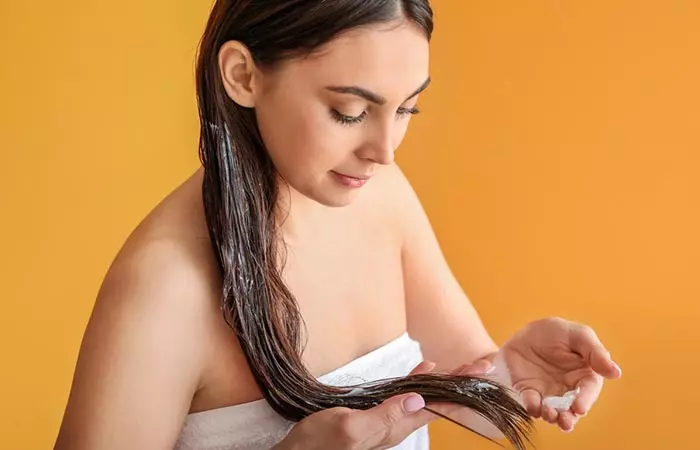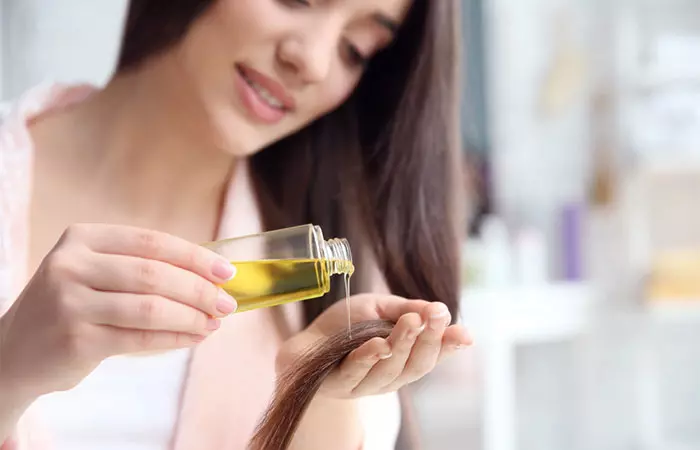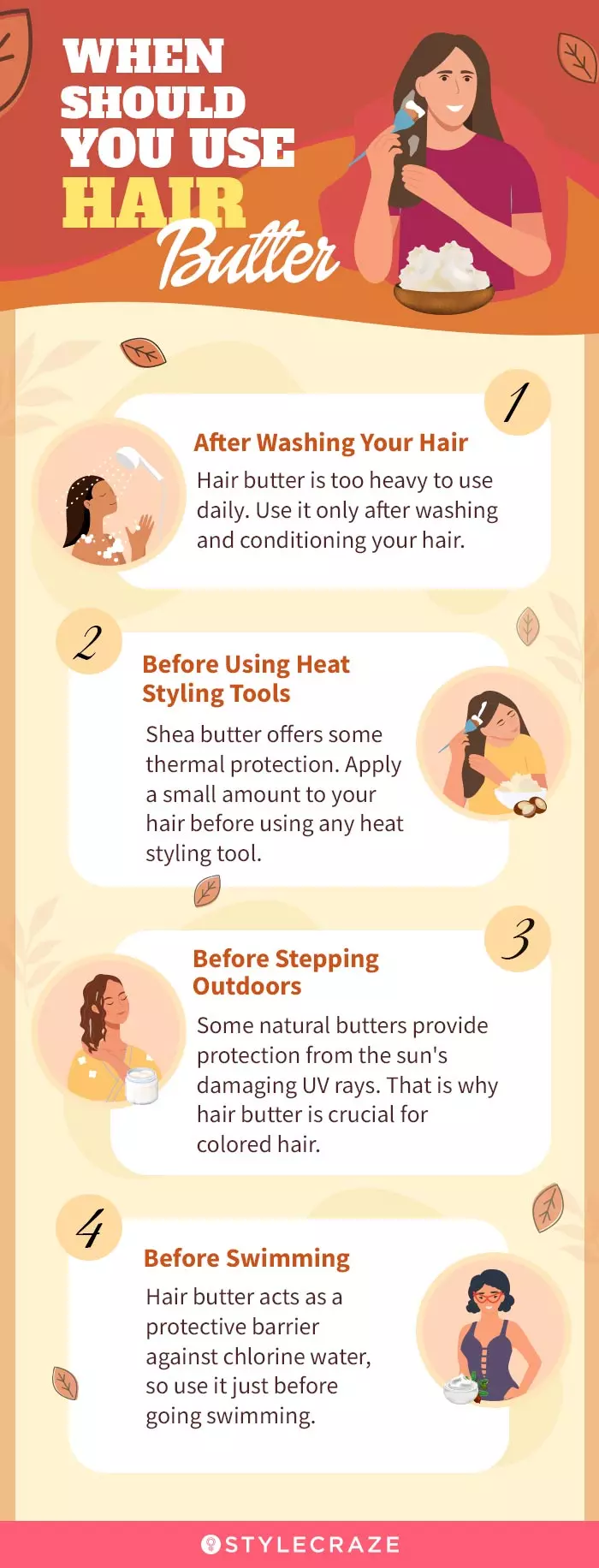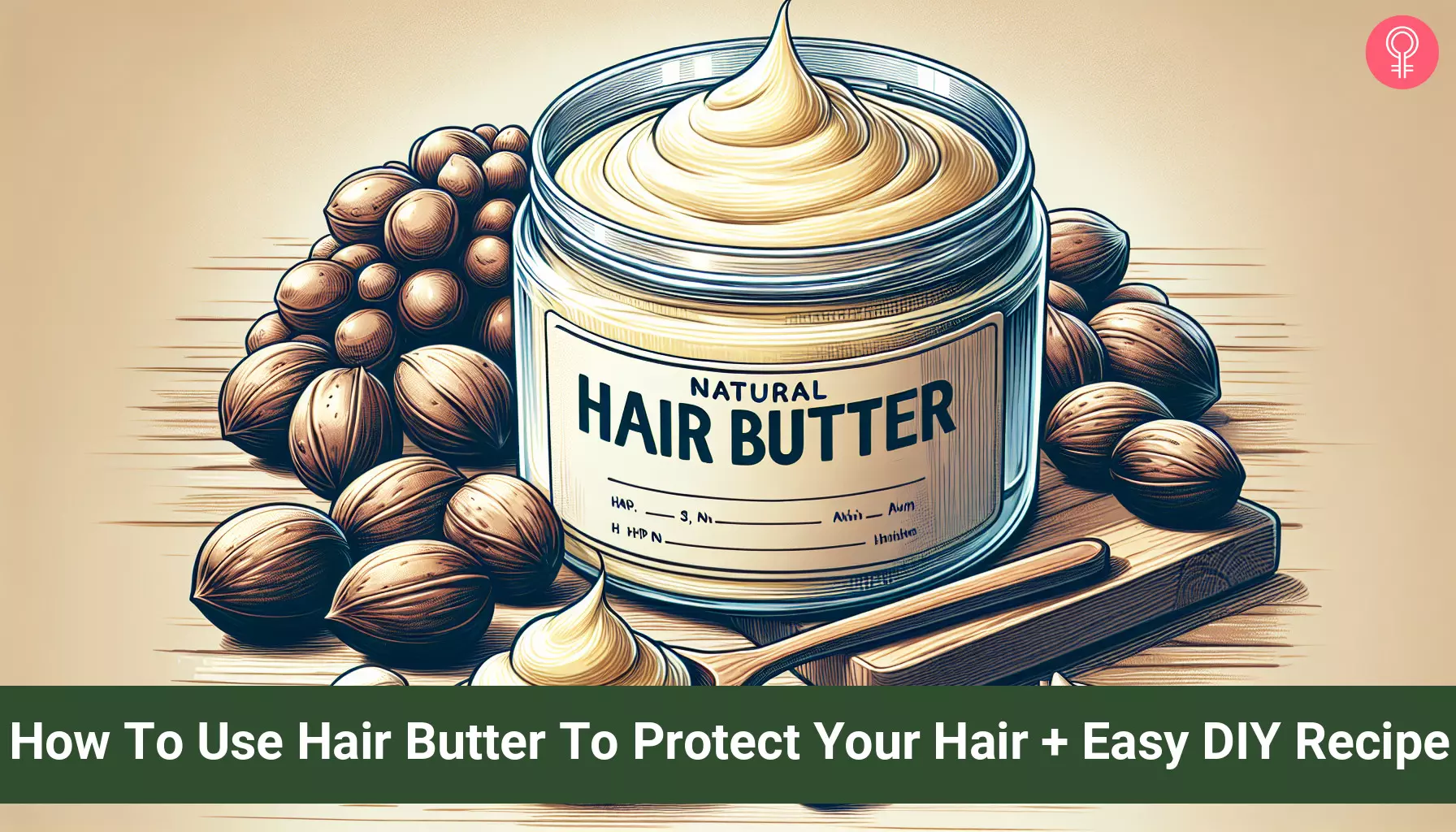The moisturizing properties of a rich hair butter lock in moisture to your tresses and guard against breakage. It is usually made of natural oils and other hydrating agents and works well for natural and over-processed hair. The best part is – you can prepare hair butter at home. Keep reading to learn how to prepare hair butter and the right way to use it.
What Is Hair Butter? How Does It Work?
Hair butter is a moisturizer for your hair and contains a blend of unprocessed natural oils and fats derived from plants (also referred to as butters). The most common plant oils/fats used to prepare hair butter are kokum, cocoa, mango, murumuru, sal or shorea, tucuma, and shea butter. These are mixed with natural oils like coconut, hemp seed, castor, almond, and avocado oil. This rich and hydrating blend of ingredients deeply nourishes and moisturizes your hair, reduces dryness and frizz, and prevents breakage. Hair butter is especially beneficial for natural hair and is used during protective styling to keep the strands nourished for days. Hair butter is also good for damaged and over processed hair that demands intense moisturizing. Goody, a blogger, shared her personal experience of using a DIY hair butter in her blog post. She said,“I decided to try my luck at making something else. Last week, I made a hair butter and it left my hair feeling soft even up to now (i).” Here is an easy recipe if you are wondering how to make hair butter for natural and damaged hair at home.
Easy DIY Hair Butter Recipe
It is easy to come up with your homemade hair butter:
1 ½ cups of shea butter (you may use cocoa, mango, or kokum butters) 2 tablespoons of hemp seed oil 2 tablespoons of coconut oil 2 tablespoons of castor oil 5-6 drops of any essential oil (like lavender, peppermint, rosemary oils) Mixing bowl Hand blender A glass storage jar with a lid (clean and dry)
Procedure
How To Use Hair Butter
As A Hair Mask
As A Leave-In Conditioner
As Pre-Conditioner
Here are a few dos and don’ts you need to keep in mind while using natural hair butter.
Dos And Don’ts Of Using Hair Butter
Dos
Apply hair butter only to clean hair. Using hair butter on dirty hair may cause buildup and lead to hair fall. Before applying hair butter, wash your hair with lukewarm water to open up the cuticles. This allows for better absorption. Use hair butter on damp or moist hair to maximize its hydrating effects. Pay attention to the problem areas of your hair. While applying hair butter, focus on the hair ends as they are far from the scalp and lack natural oils.
Don’ts
Do not reapply hair butter unless you have washed off the residue from your previous application. Do not use hair butter excessively as it can weigh your hair down. Do not combine your hair butter with other hair products like mousses and gels. This may cause buildup and greasiness. Do not mix natural hair butter with chemical products and ingredients. This may reduce the efficacy of the butter.
Hair butter provides intensive deep conditioning. It is a thick product with a creamy texture and is better suited for people with highly porous hair.
Who Should Use Hair Butter?
You can use hair butter if:
you have high porosity hair you have curly and wavy hair your hair is thick and coarse your hair breaks easily and is dry your hair is damaged and has split ends
Hair and body butters may appear similar, but there is a subtle difference between the two. If you are confused between both type of butters, scroll down to the next section.
Hair Butter And Body Butter: What Is The Difference?
Both hair and body butters are oil-based formulations. The only difference lies in the choice of oils for both products. Hair butter contains oils that are beneficial for the scalp and hair, while body butter contains carrier oils such as argan oil and jojoba oil that work best for the skin. Also, hair butter tends to be greasier than body butter. That is why skin butter recipes often include tapioca powder or an emulsifier to reduce the greasiness. In the following sections, we have answered a few questions that you may have regarding hair butter.
Do You Need A Preservative In Hair Butter?
No. Natural hair butter recipes do not need preservatives. You may prepare it in small batches and store the butter in a clean and dry jar. Keep it away from moisture to prevent bacterial and fungal growth.
Do You Have To Wash Out Hair Butter?
Yes. You may wash it off after a few hours or the next day of application to prevent buildup and greasiness. For natural hair, you may leave it on until the next hair wash.
Does Hair Butter Promote Hair Growth?
There is no clinical evidence to prove that hair butter promotes hair growth. However, hair butter can moisturize your locks, prevent damage and breakage, and help maintain your hair health.
Which Butter Is Best For Hair?
You may use shea, murumuru, kokum, aloe, tucuma, cupuacu, or mango butter for your hair as they can all hydrate and soften your hair. While hair butters have recently gained popularity, hair oils have always been the top choice. But there are still some aspects in which hair butters top hair oils. Read on to learn which one would be a more ideal option for you.
Hair Butter Vs. Hair Oil
Hair butters are rich in saturated fats that make them more effective in penetrating the hair follicles, while hair oils contain high levels of polyunsaturated fats that make them less permeable. Hair oils help retain moisture in the strands, which in return reduces frizziness and hair breakage and thus can be recommended for curly and fine hair. Hair butters, on the other hand, help with deeply nourishing the hair and combat dryness, which can make it a suitable choice for kinky and dry tresses. However, hair butters are heavier than hair oils and may cause buildup. Therefore, when it’s about hair butters, a little goes a long way. What is the difference between hair butter and hair cream? The key difference between hair butter and hair cream is that while hair butter has an oil base, hair cream has a water base. Hair creams prevent the loss of moisture and help in styling and giving definition to your hair. Hair butter locks the moisture in your hair. What butters are good for low-porosity hair? You need moisture-rich natural butter for low-porosity hair. You can use avocado, pistachio, murumuru, or cupuacu butter for hair with low porosity. What butter is good for 4c hair? Type 4c hair has the tightest curl pattern of all hair types. Unrefined shea butter is highly recommended for this hair type. Can you use shea butter on high-porosity hair? Yes. You can use shea butter for hair that has high porosity, as it is a good moisture sealant, and creates a thick barrier around the hair strands to lock the moisture in.
Illustration: How To Use Hair Butter To Protect Your Hair + Easy DIY Recipe
Learn how to make your own herbal hair butter and cream with this easy tutorial! Get ready to nourish and protect your hair with natural ingredients.












